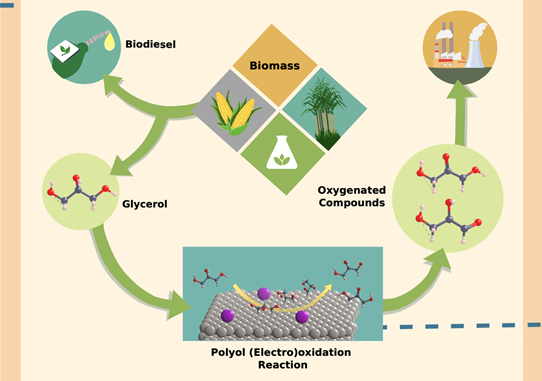
A doutoranda em Química na Universidade Estadual de Campinas (Unicamp) e pesquisadores vinculados ao Centro de Desenvolvimento de Materiais Funcionais (CDMF), Gabriela Soffiati, apresentou os resultados de sua pesquisa na ‘XIX Brazil MRS Meeting’.
O trabalho intitulado “Improving selectivity in (electro)oxidation of polyols with Bi adatoms on Pt(111) surface”, se baseia em cálculos DFT 2 e aplica os intermediários duplo-desidrogenados de glicerol e eritritol para investigar a mudança de seletividade da reação de eletroxidação do poliol com adição de bismuto na superfície de Pt (111).
Também foram autores do trabalho os pesquisadores Victor Y. Yukuhiro, Matheus B. C. de Souza, Edison Z. Da Silva, Pablo S. Fernández e Miguel A. San-Miguel.
Confira abaixo o resumo do trabalho de Soffiati:
Resumo
Since the mid-1990s, biomass-derived energy sources have been explored as the world is looking for fossil-based fuels alternatives. This important renewable energy source comprises C1 to C6 oxygenated species, from formic acid to sorbitol; some of them, such as glycerol, can be reactants to platform chemicals of industrial interest. The employment of these species in (electro)oxidation reaction has been explored for several catalysts, including multimetallic alloys, metal oxides, nanoparticles, and others. Among all, we highlight the extensive use of noble metals. Thus, Au, Pd, and Pt can oxidize with efficiency. One particular interest is the modification of platinum surfaces with bismuth adatoms. Kimura et al.¹ reported the results of glycerol oxidation with bismuth incorporation to platinum supported on charcoal. They observed glyceraldehyde (GLD) and glyceric acid as the main oxidation products, both derived from the oxidation of the primary hydroxyl group. With bismuth addition, dihydroxyacetone (DHA) became the main oxidation product, generated from the oxidation of the secondary hydroxyl group. The study proposed that Bi atoms work as site blockers on Pt surface and control the orientation of glycerol, resulting in the oxidation of the secondary hydroxyl group. In this context, we extended our previous approach based on DFT calculations 2 , using the double-dehydrogenated intermediates of glycerol and erythritol, to investigate the selectivity change of the polyol electrooxidation reaction with bismuth addition on Pt(111) surface. Our results demonstrate a significant reaction selectivity change in presence of Bi adatoms, favouring the oxidation of the secondary hydroxyl group in agreement with the experimental evidences.
______________________________________________________________________________
CDMF
O CDMF é um dos Centros de Pesquisa, Inovação e Difusão (Cepids) apoiados pela Fundação de Amparo à Pesquisa do Estado de São Paulo (Fapesp), e recebe também investimento do Conselho Nacional de Desenvolvimento Científico e Tecnológico (CNPq), a partir do Instituto Nacional de Ciência e Tecnologia dos Materiais em Nanotecnologia (INCTMN).

